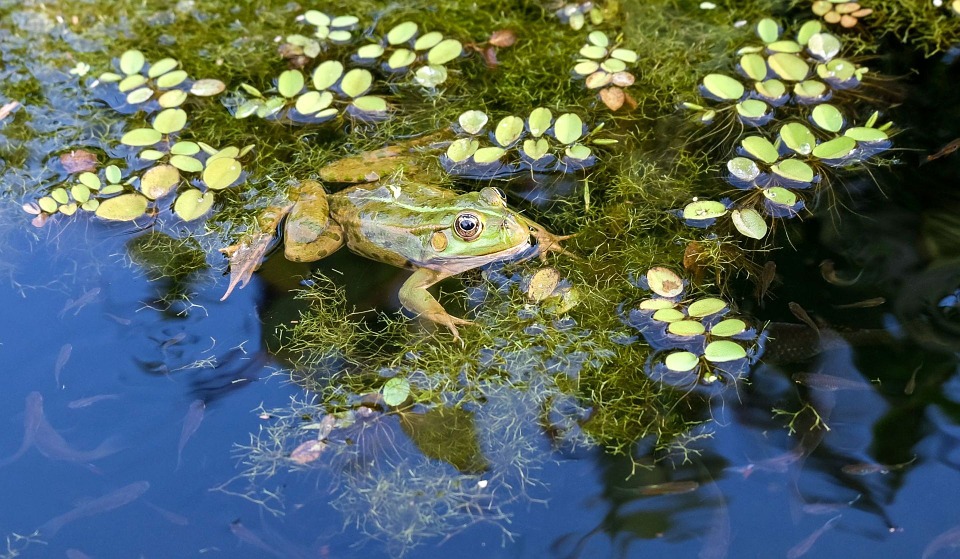Why creating new ponds helps to protect the ecosystem
Contents |
[edit] Introduction
At the start of the 20th century, there were around a million freshwater ponds in Britain, supporting a biodiverse mix of animals, plants and herbs. By the turn of this century, half had disappeared and, according to research by charity Pond Conservation, 80% of those remaining were in a poor condition and most were polluted.
[edit] Declining environments
Increased building development in the countryside and intensification of the landscape have been blamed for the decline in ponds. Agricultural chemicals from neighbouring farmlands are the main cause, leading to ponds becoming overgrown and stagnant, and the subsequent failure of the ecosystem.
Ponds need clean water to thrive, but once pollutants enter the water, the delicate ecosystem breaks down, leading to loss of habitat for threatened species such as toads, newts and frogs. A total of 105 rare and declining pond species are a national priority for conservation action under the Government’s Biodiversity Action Plan.
To counteract the loss of ponds in the UK, the charity Pond Conservation launched its Million Ponds project, aiming to replace half a million ponds within the next 50 years and so protect freshwater wildlife.
[edit] How does the pond ecosystem work?
A pond ecosystem works with the natural environment to provide food and protection to the wildlife and plants it supports. Fish nibble on the plants and algae, producing waste that is broken down and absorbed as nutrients by the plants. These plants filter the water naturally and help keep harmful algae to a minimum.
The importance of ponds for biodiversity has only recently been understood. Research has found that invertebrate biodiversity and abundance is greater in ponds than in rivers.
Frogs, toads and newts use small ponds to breed, while large ponds can support waterfowl, including mallard ducks, moorhens and coots. The grey heron also regularly visits even the smallest ponds, feeding on fish and amphibians.
[edit] Lining ponds
Pond liners are the ideal solution for creating a richly biodiverse and sustainable pond. Water loss is a significant issue for ponds, due to normal ground absorption and adverse weather conditions, such as drought.
Liners not only significantly reduce water loss, but also minimise the amount of silt that can enter the water. For manufactured ponds created for aesthetic reasons, such as those on golf courses, less silt production will maintain water clarity. Liners also prevent water contamination by acting as a barrier against pollutants in the ground.
[edit] Using geomembrane
Geomembrane liners are impermeable barriers that prevent water from passing through. They are ultra-strong and durable, as well as being completely customisable – so they can be used to line a small fish pond or large man-made fishing lake, for example.
The liners are flexible and resistant to punctures and will withstand debris, such as rocks and branches. They are also resistant to temperature variations from snow and ice to drought conditions.
Most importantly, geomembrane is totally eco-friendly and environmentally safe, so it is harmless to wildlife and vegetation.
[edit] Safeguarding future biodiversity
Phase II of the Million Pounds Project is taking place in England and Wales. Its completion may result in the creation of 30,000 new clean water ponds will have been created.
This article originally appeared in the Architectural Technology Journal (at) issue 133 published by CIAT in Spring 2020. It was written by Scott Parnell, Water Management Ltd.
--CIAT
[edit] Related articles on Designing Buildings Wiki
Featured articles and news
Delivering for tenants; National Retrofit Hub
New report offers recommendations to strengthen energy efficiency standards to protect private renters.
Government consultations for the summer of 2025
A year of Labour, past and present consultations on the environment, the built environment, training and tax.
CMA competitiveness probe of major housing developers
100 million affordable housing contributions committed with further consultation published.
Homes England supports Greencore Homes
42 new build affordable sustainable homes in Oxfordshire.
Zero carbon social housing: unlocking brownfield potential
Seven ZEDpod strategies for brownfield housing success.
CIOB report; a blueprint for SDGs and the built environment
Pairing the Sustainable Development Goals with projects.
Types, tests, standards and fires relating to external cladding
Brief descriptions with an extensive list of fires for review.
Latest Build UK Building Safety Regime explainer published
Key elements in one short, now updated document.
UKGBC launch the UK Climate Resilience Roadmap
First guidance of its kind on direct climate impacts for the built environment and how it can adapt.
CLC Health, Safety and Wellbeing Strategy 2025
Launched by the Minister for Industry to look at fatalities on site, improving mental health and other issues.
One of the most impressive Victorian architects. Book review.
Common Assessment Standard now with building safety
New CAS update now includes mandatory building safety questions.
RTPI leader to become new CIOB Chief Executive Officer
Dr Victoria Hills MRTPI, FICE to take over after Caroline Gumble’s departure.
Social and affordable housing, a long term plan for delivery
The “Delivering a Decade of Renewal for Social and Affordable Housing” strategy sets out future path.
A change to adoptive architecture
Effects of global weather warming on architectural detailing, material choice and human interaction.
The proposed publicly owned and backed subsidiary of Homes England, to facilitate new homes.
How big is the problem and what can we do to mitigate the effects?
Overheating guidance and tools for building designers
A number of cool guides to help with the heat.
The UK's Modern Industrial Strategy: A 10 year plan
Previous consultation criticism, current key elements and general support with some persisting reservations.
Building Safety Regulator reforms
New roles, new staff and a new fast track service pave the way for a single construction regulator.



























